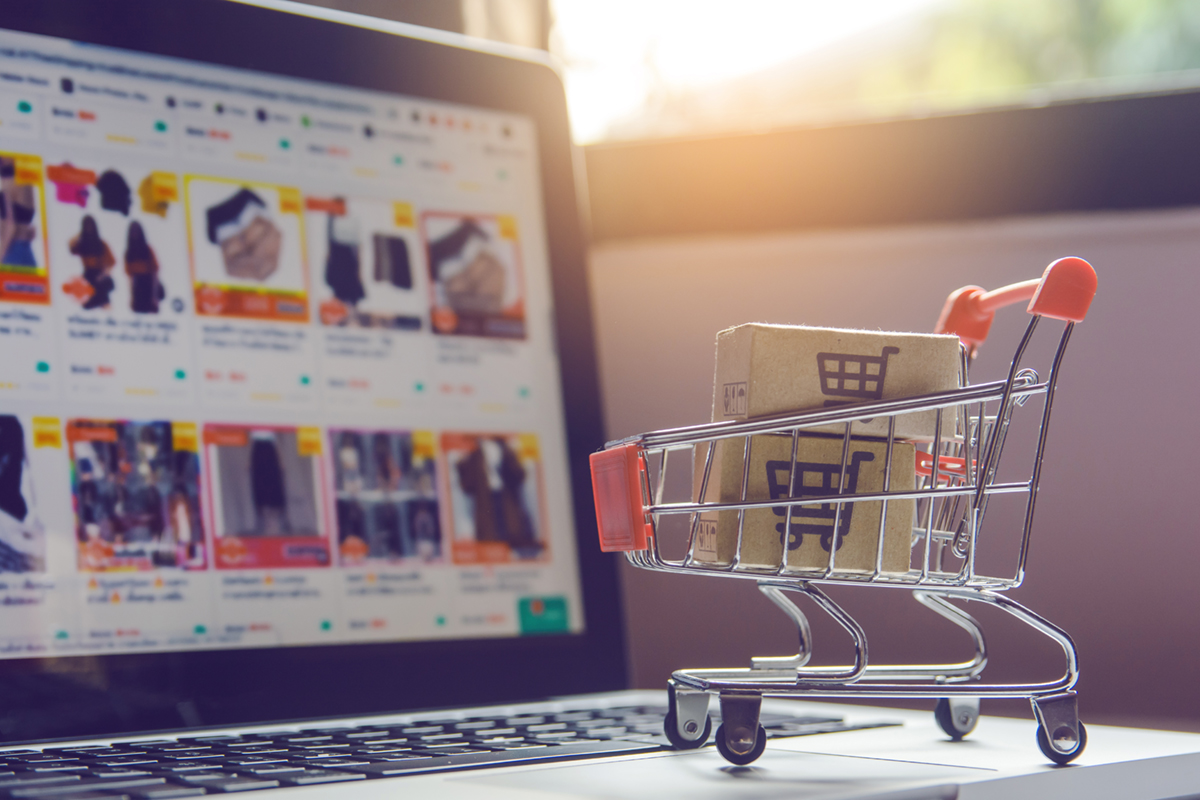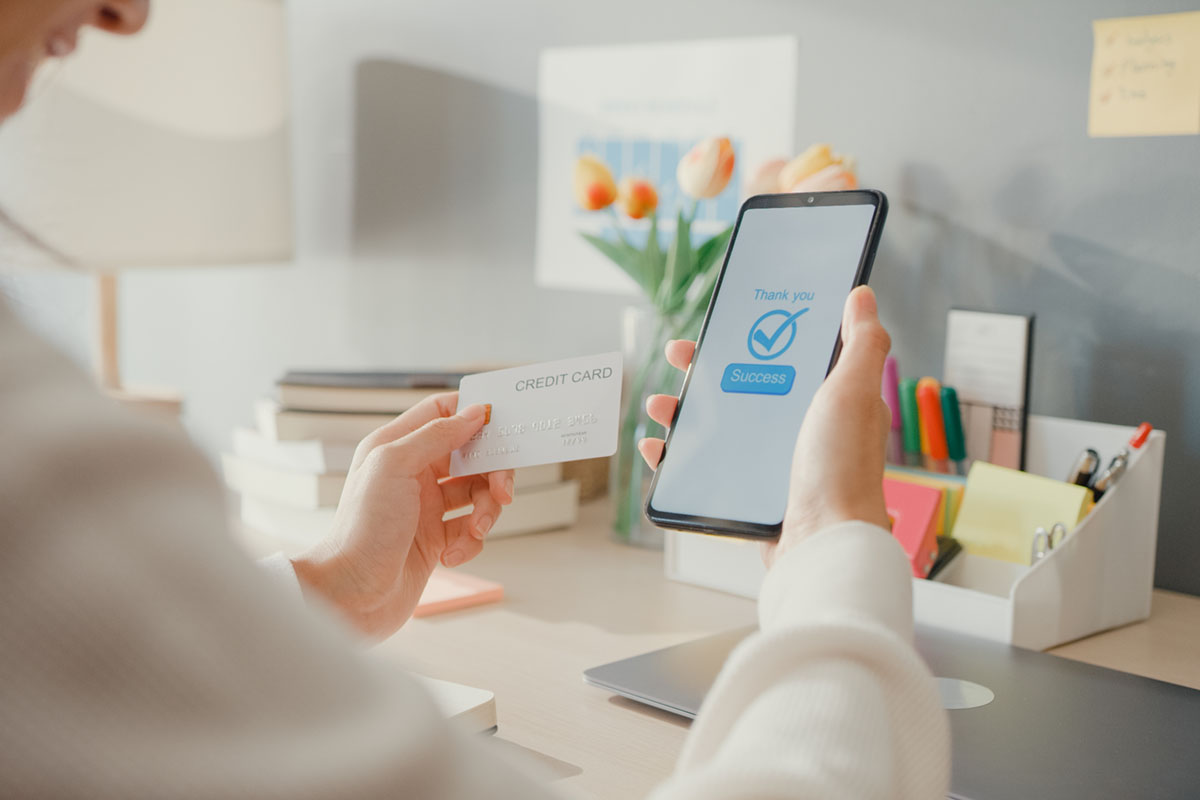Did you know that in the United States, online sales are expected to reach $1.3 trillion by 2025? That’s a lot of money up for grabs, and if you have an e-commerce website, you want to make sure that you’re doing everything possible to maximize your profits.
Luckily, there are plenty of ways to to design an eCommerce site for maximum sales. In this article, we’ll share 15 of the best tips you should start using today to take your eCommerce site to the next level!
1. Make sure your website is responsive
In today’s world, it’s more important than ever to have a responsive website. This means that your website should be able to adapt to any device, whether it’s a desktop computer, a tablet, or a smartphone.
According to Statista, 54.9% of all digital traffic now comes from mobile devices, so if your website isn’t responsive, you’re missing out on a huge chunk of potential traffic.
What’s more, Google now penalizes non-responsive websites, so if you want your e-commerce website to be visible in search results, you need to make sure it’s responsive.
A responsive website means:
- The website automatically adjusts to the size of the screen: When a user visits your website on a mobile device, they should be able to see all the content without having to zoom in or scroll horizontally.
- The website loads quickly: Mobile users are impatient, and if your website takes too long to load, they’re likely to click away.
- There are no broken links or missing images: All the links on your website should work, and all the images should be visible.
- The navigation is easy to use: The menus on your website should be easy to navigate, even on a small mobile screen.
2. Use high-quality images
The quality of the images you use on your eCommerce store can have a big impact on your sales. After all, people are visual creatures, and if they see a product that looks good, they’re more likely to buy it.
When choosing images for your website, make sure to use high-resolution pictures that are clear and well-lit. Avoid using stock photos if possible, as these can often look fake and make your products seem less appealing.
If you’re selling products that come in different colors, it’s a good idea to use images that show all the available colors. This way, customers can see what each product looks like and make a more informed decision.
High-quality images can:
- Make your products look more appealing: People are more likely to buy a product if it looks good. For this reason, it’s worth investing in high-quality images.
- Help customers see what they’re buying: Customers want to know what they’re getting before they make a purchase. By using clear and well-lit images, you can help them make an informed decision.
- Increase your search engine ranking: Google’s algorithm takes into account the quality of the images on your website when determining your search engine ranking. So, if you want to rank higher in search results, make sure to use high-quality images.

3. Use easy-to-understand language
The language you use on your e-commerce website should be easy to understand. This means avoiding industry jargon and using simple, straightforward language.
The reason for this is that you want to make it as easy as possible for people to find what they’re looking for on your website. If they have to search for a product or can’t understand the descriptions, they’re likely to click away and look elsewhere.
To make sure your website is easy to understand, avoid using:
- Jargon: If you use industry jargon or acronyms, people might not be able to understand what you’re talking about. These terms might be familiar to you, but they could be confusing for someone who’s not in the industry.
- Technical language: If you use too much technical language, people might feel like they need a degree to understand your website. Stick to using simple, straightforward language instead.
- Long sentences: Keep your sentences short and to the point. This will make it easier for people to scan your website and find the information they’re looking for.
- Time-sensitive language: If you use language that’s time-sensitive, people might feel like they need to hurry to take advantage of your offer. For example, avoid using phrases like “limited time only” or “while supplies last.”
4. Use persuasive copy
The copy on your e-commerce website should be persuasive, as this can convince people to buy your products. To write persuasive copy, you need to:
- Use strong headlines: Your headlines should be attention-grabbing and make people want to read more.
- Appeal to emotions: People are more likely to buy a product if they feel an emotional connection to it. For this reason, it’s important to use copy that appeals to emotions like happiness, fear, or anger.
- Tell a story: Stories are more memorable than facts, so try to incorporate them into your copy. This will make people more likely to remember your products and come back to your website.
- Use persuasive words: Words like “free,” “guaranteed,” and “proven” can help persuade people to buy your products.
- Make it easy to read: People are more likely to buy a product if they can easily read and understand the copy. For this reason, it’s important to use clear and concise language.
5. Offer discounts and deals
People are always on the lookout for a good deal, so offering discounts and deals is a great way to increase sales. Some ideas for discounts and deals include:
- Free shipping: Offering free shipping is a great way to persuade people to buy your products.
- BOGO (buy one, get one): This type of discount allows people to get two products for the price of one.
- Discounts for loyalty: If someone frequently buys from you, offer them a loyalty discount to keep them coming back.
- Discount codes: You can promote discount codes through your email list or social media channels.
While designing your e-commerce online stores, make sure to keep these offers and discounts:
- Easy to find: Place your offers and discounts in a prominent location on your website so people can easily find them.
- Easy to use: Make sure your offers and discounts are easy to use so people don’t get frustrated when trying to redeem them.
- Timely: Keep your offers and discounts up-to-date so people don’t feel like they’re missing out on a better deal.
6. Make it easy to navigate
Your e-commerce website should be easy to navigate so people can quickly find what they’re looking for. To do this, you need to:
- Use clear and concise labels: Your website’s labels should be easy to understand so people know where they’re going. For instance, if you have a “Sale” section, make sure it’s clearly labeled as such.
- Use drop-down menus: Drop-down menus can help people narrow down their choices and find what they’re looking for more quickly. Even if you have a small website, consider using drop-down menus to make it easier to navigate.
- Use search functionality: A search bar can be a helpful addition to your website, as it allows people to quickly find what they’re looking for. If you have a large website, consider adding a search bar to help people navigate.
- Use breadcrumbs: Breadcrumbs are links that show people where they are on your website. For instance, if someone is looking at a product detail page, the breadcrumb might say “Home > Products > Product name.” Breadcrumbs can be helpful for people who want to backtrack or go to a different section of your website.
7. Use high-quality product images
People are visual creatures, so it’s important to use high-quality product images on your e-commerce website when it comes to online shopping. Good product images can:
- Show off your products: High-quality product images allow people to see your products in detail and understand what they’re buying.
- Persuade people to buy: Good product images can be persuasive, as they allow people to see your products in a positive light.
- Build trust: If people can see that your products are high quality, they’re more likely to trust your brand and buy from you.
When selecting product images, make sure to:
- Use high-resolution images: Blurry or low-resolution images will make your products look bad. Make sure to use high-resolution images so people can see your products in detail.
- Include multiple images: It’s a good idea to include multiple images of each product from different angles. This allows people to get a better idea of what they’re buying.
- Include a mix of images: In addition to product images, you should also include lifestyle images, which show people using your products in real life. Lifestyle images can be helpful in persuading people to buy your products.
8. Use customer reviews
Customer reviews are a valuable asset for any e-commerce store. Reviews can:
- Build trust: Customer reviews can help build trust with potential customers, as they provide an unbiased account of your products.
- Persuade people to buy: Positive customer reviews can be persuasive, as they show that other people have had a good experience with your products.
- Improve your SEO: Google uses customer reviews as a ranking factor, so including them on your website can improve your SEO.
If you’re not already using customer reviews, there are a few ways to get started:
- Ask your customers to leave reviews: You can ask your customers to leave reviews after they’ve purchased a product.
- Encourage customers to leave reviews: You can also encourage customers to leave reviews by offering them a discount or other incentive.
- Include customer testimonials: Customer testimonials are another type of review that can be helpful for your website. If you have any positive customer testimonials, consider adding them to your website.
To get the most out of customer reviews, make sure to:
- Respond to positive and negative reviews: Responding to reviews shows that you care about your customers’ experiences. If you receive a negative review, try to resolve the issue with the customer. If you receive a positive review, thank the customer for their feedback.
- Display reviews prominently: Don’t hide your customer reviews — make sure to display them prominently on your website. This will help people see them and make use of them when making a purchase decision.

9. Get easy to load theme
A fast-loading website is essential for any eCommerce business. A slow website can:
- Frustrate customers: If your website takes too long to load, people will get frustrated and may not bother to stick around.
- Hurt your SEO: Google uses page speed as a ranking factor, so a slow website can hurt your SEO.
- Lose you sales: A slow website can lose you sales, as people are less likely to purchase from a website that takes too long to load.
There are a few things you can do to improve your website’s speed:
- Use a fast hosting provider: Your hosting provider can have a big impact on your website’s speed. Make sure to research different providers and find one that offers fast speeds.
- Optimize your images: Large images can slow down your website, so make sure to optimize them for the web. You can use an online tool like TinyPNG to compress your images.
- Use a caching plugin: Caching can help speed up your website by storing a copy of your website’s data. This way, your website doesn’t have to generate product pages every time someone visits it.
- Use a content delivery network (CDN): A CDN can help speed up your website by delivering your content from servers around the world. This way, visitors can access your content from the closest server, which can improve loading times.
10. Use live chat
Adding a live chat feature to your website can be a great way to provide customer support and boost sales. Live chat can:
- Increase sales: A study by Forrester found that live chat helped increase online sales by 62%.
- Improve customer satisfaction: Live chat can help improve customer satisfaction by providing a quick and easy way for customers to get answers to their questions.
- Reduce customer support costs: Live chat can reduce customer support costs, as it provides a cheaper alternative to phone support.
If you’re not using live chat on your website, there are a few things you can do to get started:
- Install a live chat plugin: If you’re using WordPress, there are a number of live chat plugins you can use.
- Sign up for a live chat service: There are also a number of live chat services you can sign up for, such as Zendesk Chat.
- Hire a live chat agent: You can also hire someone to provide live chat support for your website. This can be a great option if you don’t have the time or resources to do it yourself.
11. Use social proof
Social proof is a psychological phenomenon where people are more likely to do something if they see others doing it. It’s a powerful tool that you can use to increase sales on your website.
There are a few things you can do to add social proof to your website:
- Add customer testimonials: Customer testimonials are a great way to show social proof on your website. If you have any positive reviews or testimonials from customers, make sure to add them to your website.
- Display customer photos: If you have any photos of customers using your products, make sure to display them prominently on your website. This can help show potential customers that people are actually using and enjoying your products.
- Show off social media followers: If you have a large social media following, make sure to showcase it on your website. This can help show potential customers that you’re popular and worth following.
12. Use color psychology
Color psychology is the study of how colors affect our emotions and behavior. It’s a powerful tool that you can use to increase sales on your website when it comes to shopping online.
There are a few things you can do to use color psychology on your website:
- Use contrasting colors: Contrasting colors can help grab attention and make your call-to-actions (CTAs) more effective.
- Use bright colors: Bright colors can help create a sense of urgency and encourage people to buy your products.
- Use blue: Blue is often associated with trustworthiness and reliability. This makes it a great color to use if you want people to feel confident about buying from your website.
13. Use FOMO
FOMO is the fear of missing out. It’s a powerful psychological phenomenon that you can use to increase sales on your website.
There are a few things you can do to use FOMO on your website:
- Create urgency: Urgency can help encourage people to buy your products before they run out. You can create urgency by displaying countdown timers or showing how many products are left in stock.
- Offer limited-time discounts: Offering discounts for a limited time can also help create a sense of urgency and encourage people to buy your products before they miss out on the deal.
- Use scarcity: Scarcity is another powerful way to create urgency. When people see that there are only a few products left, they’re more likely to buy them before they run out.
14. Use pop-ups
Pop-ups are a great way to increase sales on your website. They can help you:
- Capture email addresses: You can use pop-ups to capture the email addresses from potential customers. This can be a great way to build your email list and market to potential online shoppers in the future.
- Offer discounts: You can also use pop-ups to offer discounts on your products. This can help increase sales in the short term and encourage people to come back to your website in the future.
- Promote new products: You can use pop-ups to promote new products or collections. This is a great way to generate buzz and get people interested in what you have to offer.
15. A/B test your website
A/B testing is a process of testing two versions of your website against each other to see which one performs better. It’s a great way to improve the sales of your website.
There are a few things you can do to A/B test your website:
- Test different CTAs: You can test different call-to-actions (CTAs) to see which ones are more effective at getting people to buy your products.
- Test different color schemes: You can also test different color schemes to see which ones have a more positive effect on sales.
- Test different layouts: Testing different layouts is another great way to see which ones are more effective at getting people to buy your products.
These are just a few of the many things you can do to design an eCommerce site for maximum sales. By following these pro tips, you can help increase the sales of your website and reach your eCommerce business goals.
Conclusion
To design an eCommerce website for maximum sales, it is important to follow pro tips such as using color psychology, FOMO, and A/B testing. These tips will help increase conversion rates and improve the overall sales of your website.
However, it is important to keep in mind that there is no one-size-fits-all solution. Every website is different, and you may need to experiment with different strategies to find what works best for your eCommerce store. But if you want to increase sales on your eCommerce website, following these pro tips is a great place to start.
Want To Know More? Check Our FAQ Below!
How do you design an e-commerce website?
When building an eCommerce website, it’s important to design with your user in mind. Creating a user-friendly and easy-to-navigate website will help increase sales and keep customers coming back. Some things to consider when designing your eCommerce website include:
- The overall look and feel of the site
- The user experience (UX)
- The navigation
- The layout
- The colors and fonts
- The call-to-actions (CTAs)
What is the process of designing and building of eCommerce website?
There is no one definitive answer to this question as the process can vary depending on the team, company, or individual working on the project. However, in general, the process of designing and building an eCommerce website typically includes:
- 1. Researching and planning
- 2. wireframing and prototyping
- 3. design
- 4. development
- 5. testing and launching
Which design pattern is used in eCommerce?
There are a variety of eCommerce website design patterns that can be used in eCommerce, but some of the most popular include:
- The single-page checkout
- The mini shopping cart page
- The infinite scroll
Why is eCommerce design important?
Ecommerce design is important because it can have a significant impact on conversion rates. Good design can help improve the user experience (UX) and make it easier for customers to find what they’re looking for, which can lead to more sales. Additionally, poor design can deter potential customers from making a purchase on your site.
What is E-Commerce UX?
Ecommerce UX refers to the User Experience of an eCommerce website. User Experience includes everything from the design and layout of the site to how easy it is to navigate and find products. Creating a good UX is important as it can help increase sales and maximize customer retention.
Why UX is important for eCommerce?
User experience is important for eCommerce because it can have a significant impact on conversion rates. Good UX can make it easier for customers to find what they’re looking for, which can lead to more sales. Additionally, poor UX can deter potential customers from making a purchase on your site.
What is E-Commerce UI?
E-Commerce UI refers to the User Interface of an eCommerce website. The User Interface includes everything from the design and layout of the site to how easy it is to navigate and find products. Creating a good UI is important as it can help increase sales and conversion rates.
What is UX in Amazon?
The UX of Amazon is the User Experience of the Amazon website. User Experience includes everything from the design and layout of the site to how easy it is to navigate and find products. Creating a good UX is important as it can help increase customer retention.
Can a commerce student do UX design?
Yes, a commerce student can do UX design. In fact, many UX designers have a background in commerce or a related field. However, it is not necessary to have a background in commerce to be a successful UX website designer.
What is an eCommerce designer?
An eCommerce designer is someone who specializes in designing eCommerce websites. They typically have experience in web design, user experience (UX), and conversion optimization.
Can I build my own eCommerce website?
Yes, you can build your own eCommerce website. However, it is important to note that building an eCommerce website can be complex and time-consuming. If you’re not sure where to start, it might be worth hiring a professional to help you.
How much does it cost to build an eCommerce website from scratch?
The cost of building an eCommerce website from scratch can vary depending on a number of factors, such as the size and complexity of the site, the platform you’re using, and whether or not you hire a professional to help you. Generally speaking. However, you can expect to spend thousands of dollars on building an eCommerce website from scratch.
What makes a good eCommerce experience?
There are many factors that contribute to a good eCommerce experience. Some of the most important include a well-designed website, easy navigation, informative product descriptions, and customer reviews. Additionally, offering fast shipping and excellent customer service can also help create a positive eCommerce experience.






